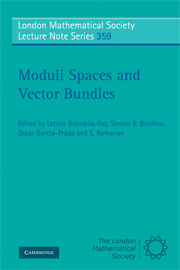Book contents
- Frontmatter
- Contents
- Preface
- Acknowledgments
- Part I Lecture Notes
- Part II Survey Articles
- 7 Moduli of Sheaves from Moduli of Kronecker Modules
- 8 Coherent Systems: a Brief Survey
- 9 Higgs Bundles Surface and Group Representations
- 10 Quotients by Non-Reductive Algebraic Group Actions
- 11 Dualities on T*SUX (2, OX)
- 12 Moduli Spaces for Principal Bundles
- Part III Research Articles
10 - Quotients by Non-Reductive Algebraic Group Actions
Published online by Cambridge University Press: 07 September 2011
- Frontmatter
- Contents
- Preface
- Acknowledgments
- Part I Lecture Notes
- Part II Survey Articles
- 7 Moduli of Sheaves from Moduli of Kronecker Modules
- 8 Coherent Systems: a Brief Survey
- 9 Higgs Bundles Surface and Group Representations
- 10 Quotients by Non-Reductive Algebraic Group Actions
- 11 Dualities on T*SUX (2, OX)
- 12 Moduli Spaces for Principal Bundles
- Part III Research Articles
Summary
This paper is dedicated to Peter Newstead, from whose Tata Institute Lecture Notes [Ne] I learnt about GIT and moduli spaces some decades ago, with much appreciation for all his help and support over the years since then.
Introduction
Geometric invariant theory (GIT) was developed in the 1960s by Mumford in order to construct quotients of reductive group actions on algebraic varieties and hence to construct and study a number of moduli spaces, including, for example, moduli spaces of bundles over a nonsingular projective curve [MFK, Ne, Ne2]. Moduli spaces often arise naturally as quotients of varieties by algebraic group actions, but the groups involved are not always reductive. For example, in the case of moduli spaces of hypersurfaces (or, more generally, complete intersections) in toric varieties (or, more generally, spherical varieties), the group actions which arise naturally are actions of the automorphism groups of the varieties [Co, CK]. These automorphism groups are not in general reductive, and when they are not reductive we cannot use classical GIT to construct (projective completions of) such moduli spaces as quotients for these actions.
In [DK1] (following earlier work including [Fa, Fa2, GP, GP2, W] and references therein) a study was made of ways in which GIT might be generalised to non-reductive group actions; some more recent developments and applications can be found in [AD, AD2]. Since every affine algebraic group H has a unipotent radical U ⊴ H such that H/U is reductive, [DK1] concentrates on unipotent actions.
- Type
- Chapter
- Information
- Moduli Spaces and Vector Bundles , pp. 311 - 366Publisher: Cambridge University PressPrint publication year: 2009
- 4
- Cited by

